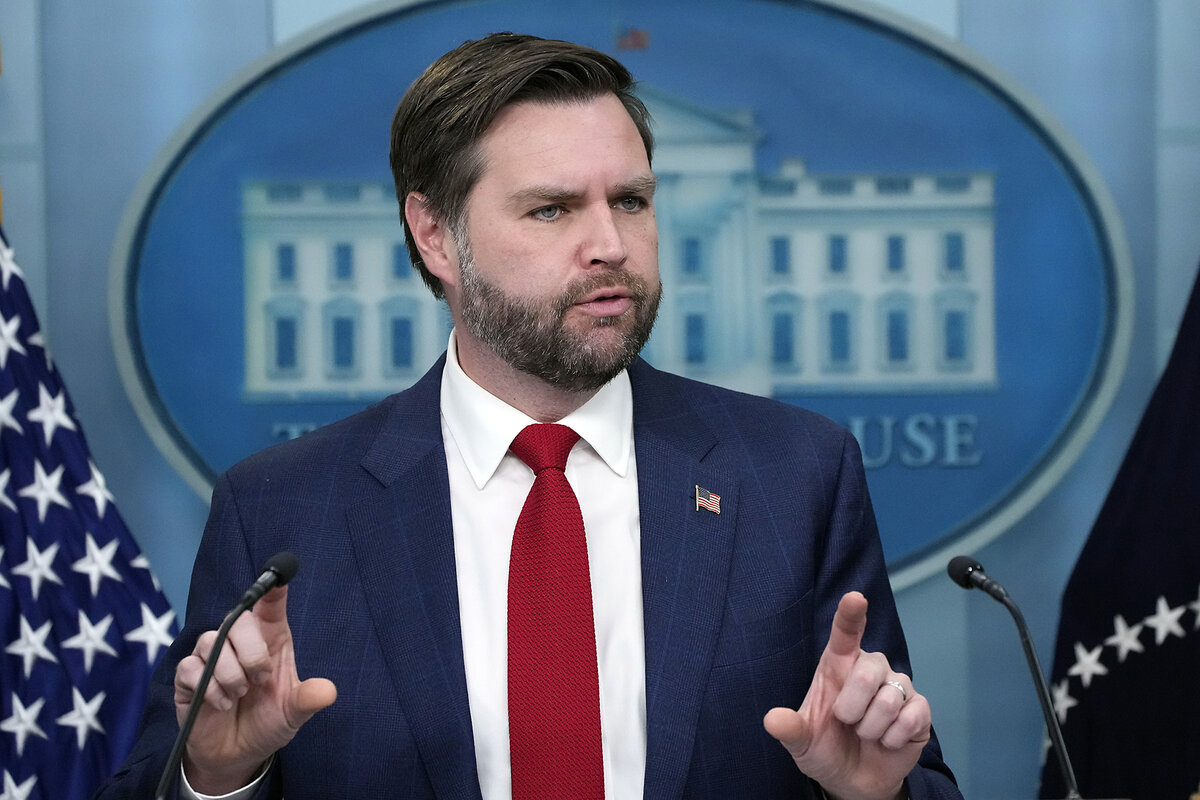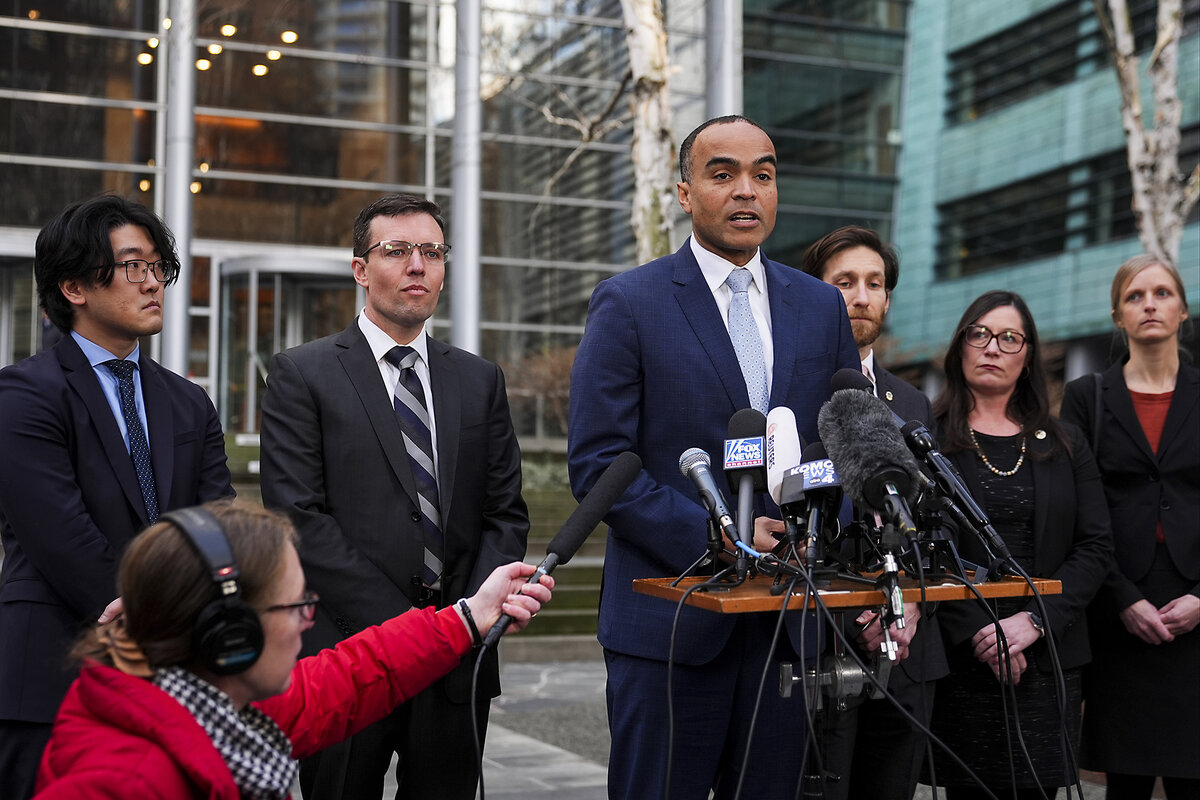As judges say ‘stop,’ the question is whether Trump will comply
Loading...
Eight years ago, a newly elected President Donald Trump issued a sweeping executive order that, in the eyes of detractors, flew in the face of bedrock American principles. The order, which critics called a “Muslim ban,” barred people from certain countries from coming to the U.S.
Opponents immediately brought lawsuits, essentially asking courts: Could a president unilaterally do this? The answer, from a series of lower federal judges, was “no.”
While Mr. Trump expressed anger about the rulings, his administration complied with them, vowing to take its case for broader executive power to higher courts. After the administration revised the order twice, the U.S. Supreme Court ultimately upheld it.
Why We Wrote This
Congress and federal courts provide a check on presidential power. The Trump administration’s early actions and words are challenging that balance.
Three weeks into his second term, lower federal courts have again been blocking a swath of executive actions by President Trump. In response, the Trump administration has been striking a different tone this time around – one crystallized on Sunday by Mr. Trump’s second-in-command.
“Judges aren’t allowed to control the executive’s legitimate power,” said Vice President JD Vance in a social media post.
Mr. Vance’s post came as courts have emerged, once again, as the principal check against Trump administration actions that could violate the U.S. Constitution. Three weeks of executive action by Mr. Trump and his subordinates – particularly Elon Musk, the multibillionaire head of the president’s effort known as the Department of Government Efficiency (DOGE) – have resulted in dozens of lawsuits filed by parties ranging from the American Civil Liberties Union to anonymous FBI agents. In many cases, federal judges have ordered a pause to Trump administration actions.
Technically speaking, everything in Vice President Vance’s post is accurate, legal experts say. But at the heart of the debate is exactly how one defines the executive’s “legitimate power.”
The Trump administration – including Mr. Musk – argues it’s the judiciary that’s overstepping. “When a president can’t look for fraud and waste and abuse, we don’t have a country anymore,” President Trump said on the same day as Mr. Vance’s post. “No judge should frankly be allowed to make that kind of a decision. It’s a disgrace.”
As prescribed by America’s founders, the scope of a president’s executive power is determined not only by the Constitution but also, in practice, by the other two branches of government: Congress and the federal courts.
The foundational principle of separation of powers depends on the judiciary blocking unlawful exercises of power by the president and Congress. Unlike the other two branches, however, the courts have little power to enforce their decisions.
“Its main enforcement power really is political and [staked to] the general support the [judiciary] might have,” says Don Kettl, a professor emeritus of public policy at the University of Maryland.
Amid concerns – and some evidence – that the executive branch is refusing to follow some federal court rulings, experts say the balance of powers feels more fragile than ever.
Mr. Vance “thinks the courts are curbing the president’s authority,” says Saikrishna Prakash, a professor at the University of Virginia School of Law.
“Is that a prelude to not honoring the judgment? I can’t say,” he adds. But “the system doesn’t work if the president can just ignore judicial judgments.”
The administration has “not fully complied”
Mr. Trump reentered the White House last month with popular support for reducing the size of the federal government. Project 2025, a conservative policy blueprint published during the Trump interregnum, outlined many of these changes. The Trump administration is now executing them, ordering broad freezes of federal government spending and pursuing widespread cuts to the federal workforce.
About 60% of Americans support “downsizing the federal government,” according to a late-January poll from Reuters/Ipsos. Courts so far have not supported how the White House has tried to achieve this, however.
The Constitution indicates the executive branch has little authority to cut off funds already approved by Congress. A group like DOGE, staffed by temporary employees and unaccountable to Congress or the public, also has limited power under federal privacy and civil service law to fire federal employees and access sensitive taxpayer information.
Two federal judges have blocked a Trump administration memo freezing all federal funding for grants and loans. Another judge has temporarily blocked a White House order suspending employees at the U.S. Agency for International Development (USAID). Another federal judge limited DOGE’s access to sensitive Treasury Department records.
Yet it appears that administration officials have not been following all these judicial orders.
On Monday, Judge John J. McConnell, a district court judge in Rhode Island, issued an order acknowledging that Trump administration officials “in some cases have continued to improperly freeze federal funds.”
In another lawsuit, plaintiffs claim in a court filing that administration officials “have not fully complied” with an order to pause placing USAID staff on administrative leave. The plaintiffs also claim the administration may be trying to shut down USAID before courts can rule on the legality of its actions.
It’s unclear what courts can do if the administration is defying court orders. Meanwhile, the Justice Department and Trump supporters are pushing back against the rulings and the judges who have issued them.
A more aggressive administration
Eight years ago, early Trump administration actions like the travel ban wilted under judicial scrutiny, and officials had little recourse except to go back and redo their work. Now, the administration appears much more prepared, not only to fight its legal battles but to continue transforming the federal government as it does so.
Take the Treasury Department. Early on, temporary employees without security clearances from Mr. Musk’s team arrived at the department’s Washington headquarters and demanded access to systems that process trillions of dollars in federal payments every year. In a late-night order last week, a federal judge issued a sweeping, albeit temporary, block on most Trump officials from accessing sensitive Treasury systems.
In response, the administration pushed back with claims that the court is overreaching. In a Feb. 9 court filing describing the order as “anti-constitutional” and “a remarkable intrusion on the executive branch,” the Justice Department asked for the order to be clarified or dissolved. On its face, the government added, the order “could be read to cover all political leadership within Treasury.”
Mr. Trump wouldn’t be the first president to ignore a court order. Abraham Lincoln, for example, defied a Supreme Court directive regarding the rights of wartime detainees. And President Joe Biden, Trump supporters frequently point out, forgave billions of dollars of student loan debt after the U.S. Supreme Court struck down a student loan forgiveness program created by his Education secretary.
But President Biden only forgave specific student loan debts that hadn’t been covered by the plan struck down in the courts, CNN reported at the time. Other presidents have exploited such legal loopholes, experts say, and have threatened to defy court orders. Rarely, however, has a president followed through on such threats.
President Richard Nixon blocked funding appropriated by Congress more frequently than any of his predecessors, leading the legislature to pass a law curtailing the executive’s ability to “impound” funds already approved by lawmakers. He also attempted to withhold secret tapes related to the Watergate investigation, citing executive privilege, but gave them up when ordered to by the Supreme Court.
President Harry S. Truman seized control of the country’s steel mills ahead of a looming strike, citing their importance to the Korean War effort, but he reversed course after the Supreme Court ruled that his actions had been unconstitutional. Years earlier, President Franklin D. Roosevelt threatened to pack the high court by expanding the number of justices, after it struck down key New Deal legislation. But he too backed down.
In each case the president complied, “because it’s what the court said, and the president believed in the legitimacy of the system,” says Dr. Kettl at the University of Maryland.
But that doesn’t mean all presidents will follow suit – and if they choose not to, it’s unclear what may happen next. The judiciary is a slow-moving institution, and even when it moves quickly, as it has in the past three weeks, it likely can’t keep pace with the Trump administration.
By the time courts issue a final ruling to the administration, it could be “hard to piece everything back together again,” says Dr. Kettl. “Even if a court says it has to.”
Staff writer Story Hinckley contributed to this report.








